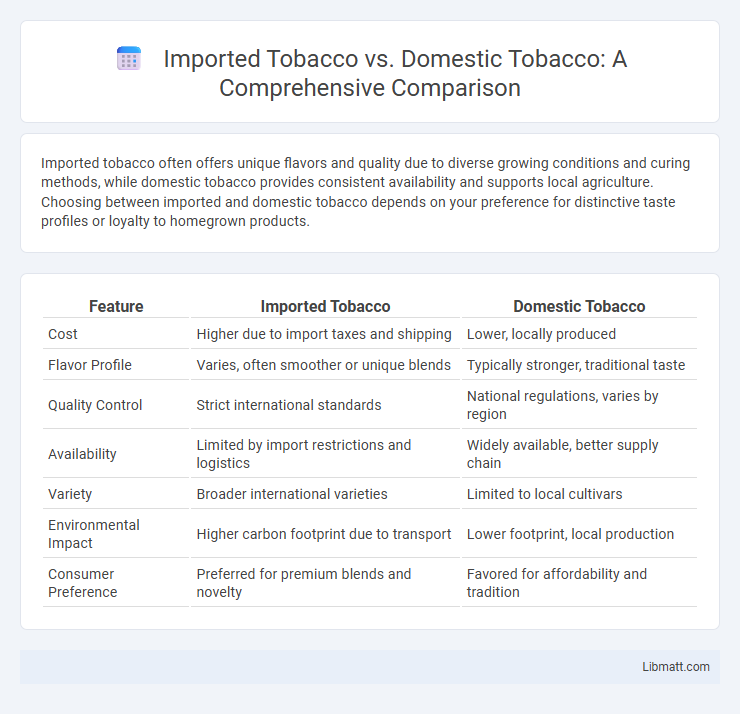Imported tobacco often offers unique flavors and quality due to diverse growing conditions and curing methods, while domestic tobacco provides consistent availability and supports local agriculture. Choosing between imported and domestic tobacco depends on your preference for distinctive taste profiles or loyalty to homegrown products.
Table of Comparison
| Feature | Imported Tobacco | Domestic Tobacco |
|---|---|---|
| Cost | Higher due to import taxes and shipping | Lower, locally produced |
| Flavor Profile | Varies, often smoother or unique blends | Typically stronger, traditional taste |
| Quality Control | Strict international standards | National regulations, varies by region |
| Availability | Limited by import restrictions and logistics | Widely available, better supply chain |
| Variety | Broader international varieties | Limited to local cultivars |
| Environmental Impact | Higher carbon footprint due to transport | Lower footprint, local production |
| Consumer Preference | Preferred for premium blends and novelty | Favored for affordability and tradition |
Introduction to Imported vs Domestic Tobacco
Imported tobacco often originates from countries with distinct climates and soil conditions, influencing its flavor profile and nicotine content, while domestic tobacco is grown within a country, adhering to local agricultural practices and regulations. The differences in curing processes, leaf types, and chemical composition create unique characteristics that appeal to diverse consumer preferences. Understanding these variations aids smokers and manufacturers in selecting tobacco that meets specific quality and taste standards.
Key Differences Between Imported and Domestic Tobacco
Imported tobacco often features unique flavor profiles and qualities influenced by foreign soil, climate, and curing methods, setting it apart from domestic varieties cultivated under local agricultural conditions. Domestic tobacco typically benefits from regional expertise and regulatory standards that ensure consistent quality, while imported tobacco can introduce exotic blends that appeal to niche markets. Understanding these key differences helps you make informed choices based on taste preferences, cost considerations, and product origin.
Quality Comparison: Imported vs Domestic Tobacco
Imported tobacco often undergoes stringent quality control processes, resulting in a more consistent flavor and higher nicotine purity compared to some domestic brands. Domestic tobacco may offer greater variety and fresher products due to localized production but can vary significantly in quality depending on the region and farming practices. Your choice between imported and domestic tobacco should consider taste preference, chemical composition, and the intended use for a well-informed smoking experience.
Price Analysis: Imported and Domestic Tobacco
Imported tobacco generally carries a higher price due to factors like import duties, transportation costs, and brand premiums. Domestic tobacco often offers more affordable options, benefiting from lower logistical expenses and local market production. Your choice between imported and domestic tobacco should consider budget constraints alongside quality preferences.
Flavor Profiles: What Sets Imported and Domestic Tobacco Apart
Imported tobacco often features a richer and more diverse flavor profile due to varied cultivation climates and curing methods found across countries like Cuba, the Dominican Republic, and Brazil. Domestic tobacco, primarily grown in the United States, tends to have a more consistent and milder taste with natural earthy and nutty notes, influenced by regional soil and climate conditions such as Kentucky and Virginia. The distinct curing processes, including air, flue, and fire curing, significantly impact the flavor profiles, setting imported and domestic tobacco apart in complexity and aroma.
Health Risks: Imported Versus Domestic Tobacco
Imported tobacco and domestic tobacco both pose significant health risks due to the presence of harmful chemicals such as nicotine, tar, and carcinogens regardless of origin. Studies reveal no meaningful difference in the concentration of toxic substances between imported and domestic brands, making both equally detrimental to lung and cardiovascular health. Regulatory standards and cultivation practices influence chemical residues but do not eliminate the overall risk associated with tobacco consumption.
Regulatory Standards and Compliance
Imported tobacco products often face stricter regulatory standards and compliance measures compared to domestic tobacco due to international trade agreements and varied country-specific health regulations. Your business must navigate complex customs inspections, labeling requirements, and certification processes to meet these rigorous standards. Ensuring thorough documentation and adherence to both domestic and foreign laws is critical to avoid penalties and ensure market access.
Consumer Preferences and Market Trends
Imported tobacco often appeals to consumers seeking premium quality, unique flavors, and brand prestige, driving higher demand in luxury segments. Domestic tobacco captures a substantial market share due to affordability, local sourcing, and strong brand loyalty among cost-conscious consumers. Your purchasing decision may hinge on preferences for flavor profiles, price sensitivity, and perceived quality differences influenced by evolving market trends and regional availability.
Environmental Impact: Domestic vs Imported Tobacco
Domestic tobacco production typically results in a lower carbon footprint due to reduced transportation distances and localized farming practices. Imported tobacco often involves extensive shipping and handling emissions, contributing to higher overall greenhouse gas output. Environmental consequences also vary with farming techniques, as domestic growers may implement stricter regulations on pesticide and water use compared to some international producers.
Conclusion: Which Tobacco is Better?
Imported tobacco often offers unique flavor profiles and higher quality control due to established international standards, appealing to connoisseurs seeking premium blends. Domestic tobacco tends to be fresher and more affordable, benefiting from local cultivation practices and reduced transportation costs. Preference ultimately depends on individual taste and budget, with imported tobacco favored for luxury or specialty use, while domestic tobacco remains popular for everyday smoking.
Imported tobacco vs Domestic tobacco Infographic

 libmatt.com
libmatt.com